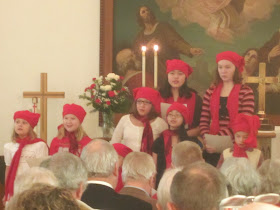Activities
Since Sophia and Olivia were both five years old (7 years ago and 5 years ago respectively), they have been a part of the children's choir at church. Each year, they take part in the St. Lucia Day service by singing at both services.
The girls singing to a full congregation.
First, they go on stage and begin to sing the St. Lucia song as two teenage girls and a boy process down the aisle. Then a teenage girl who represents St. Lucia comes down the aisle with the crown on candles on her head.
The teens representing St. Lucia and her Court stand behind
the children's choir as they sing the St. Lucia song.
The congregation and children continue to sing the St. Lucia song.
The children are singing a song about tomtens.
After that, the children's choir sings a song about tomtens. Since this is a Swedish-settled community, there are a lot of families who grew up hearing about tomtens. We hadn't heard about them until moving here.
Each year the children wear red hats and scarves
during the St. Lucia service.
After the first service and before the second one, there were several ladies dressed up in Swedish costumes who hosted a reception. There was a table filled with a variety of Swedish treats.
*~*~*~*~*~*~*
Advent Reading
Luke 2:1-4 - At that time Emperor Augustus ordered a census to be taken throughout the Roman Empire. When this first census took place, Quirinius was the governor of Syria. Everyone, then, went to register himself, each to his own hometown.
Joseph went from the town of Nazareth in Galilee to the town of Bethlehem in Judea, the birthplace of King David. Joseph went there because he was a descendant of David.
*~*~*~*~*~*~*
Christmas Joke
What would a reindeer do if it lost its tail?
Sophia and Olivia by reindeer.
They went on a sleigh ride on December 18, 2008,
which they both enjoyed.
(Go to a “re-tail” shop for a new one.)
*~*~*~*~*~*~*
Christmas Fact
We learned how Nativity scenes became popular thanks to Holy Land Treasures:
The term "Nativity scene" is thought to have been used for the first time with regard to St Mary Major’s Basilica on the Esquiline Hill in Rome, known since the 7th century as “Sancta Maria ad praesepe” because according to tradition it was here the that the relics of the Cradle of Jesus were brought.
Nativity scene at church.
An encyclopedia describes the Nativity scene as a three dimensional representation of the birth of Jesus Christ, composed of mobile figures arranged according to the artistic sense of the builder as well as realistic elements (e.g., rocks, plants, houses) which is prepared for Christmas and removed after. As such the Nativity set is closely related to the theater.
With time the tradition of the Nativity set evolved in various phases. Sets were first found in churches, and this was the ecclesiastical period. The Nativity set figures at first painted and then carved, were placed at side altars and chapels specially reserved for the Nativity set. Later came the aristocratic period in which the tradition of a Nativity scene in the home became popular and Nativity Sets were ever richer and more pretentious, but also highly artistic.
Lucy by the Nativity set.
Scholars agree that the oldest Nativity set in Italy is a Nativity Scene in marble attributed to Arnolfo di Cambio around 1289. Although some of the figurines were broken or lost, this Nativity set can still be seen today in the Basilica of St Mary Major in Rome. Until 1870, many Popes came here to celebrate Christmas Mass.
The 17th century saw the appearance and development of scenic effects which revolutionized Nativity sets. Nativity Scenes became a mirror for the culture which produced them, reflecting the society of the day with traits of intense realism. Nativity sets and Nativity scenes were enriched with unusual and exotic elements and spectacular scenery, displaying inventive imagination typical of Baroque.
At this time Nativity sets began to step out of churches to enter homes as an object of luxury interior decoration, mounted and remounted differently year after year.
The large statues were replaced with wooden figures sometimes partly of straw with head and limbs in terracotta, wax or wood adorned with sumptuous clothing, fostering private Nativity sets.
Meenie and Shadow on and by the Nativity set.
In the 19th century, inexpensive Nativity figures in clay, plaster, or papier-mache were produced to satisfy the demand of an ever-widening public. Artists were replaced by artisans who often used molds and there was a repetition of old themes, without the addition of new original elements.






No comments:
Post a Comment
Thanks for taking time to read my blog and share your comments. Have a great day!